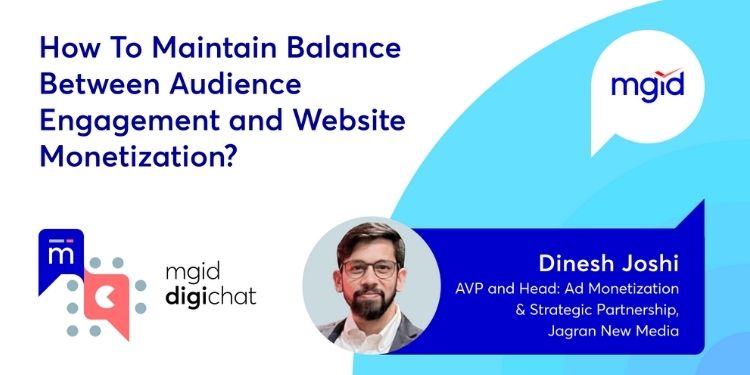One of the major challenges for digital publishers has always been to maintain balance between monetization and user engagement, which often appears as a Catch-22 situation. Publishers want to drive more users on their websites to generate more revenue, but more revenue often means using monetization channels that intrude on the user engagement. Being able to strike the right balance requires employment of the right strategies so that publishers win on both fronts.
To discuss this balancing act in detail Pankaj Sharma, CEO & Director, MGID India is joined with Dinesh Joshi, AVP and Head: Ad Monetization & Strategic Partnership, Jagran New Media.
Below are a few excerpts from their discussion:
Pankaj Sharma: What are the various ways to increase audience engagement?
Dinesh Joshi: One of the first things needed to boost audience engagement is a simple and interactive website interface. The layout of the website should be clean and easy to follow. The website pages should have a balance of strong content and opportunity for the user to interact with the page. Moving on to the technical aspect of audience engagement, reducing page load time should be a priority. If a page takes too long to load the user is most likely to exit and move on to the next website. Publishers should focus on improving their internal linking system and website navigation so that the time spent by the user within the website increases. We are aware that audience makes use of multiple devices to visit the website, and each has different dimension, which highlights the need for the website to be responsive so that the user experience in not compromised. These are some primary ways by which a website can work on increasing its audience engagement.
Pankaj Sharma: Do you think there have been significant changes in the behaviour pattern Dinesh Joshi: The pandemic has most definitely had an unprecedented impact on the online behavior patterns of users. The acceleration in adoption of digital platforms, such as online shopping apps, short video platforms, video on demand apps and even social media, is one of the most obvious and relatable trends that have been driven by the pandemic, and it will most certainly follow in the post pandemic era as well. There are more people shopping online, learning new skills, watching and streaming online content, looking for opportunities for innovation and even focusing on mental health. Gaming as an industry has also seen a huge surge in the number of players and in the total time spent globally as well as increase in spends on games and gaming accessories.
While it might be difficult to accurately predict which of these trends will stick and which might go out of fashion in the post pandemic era, it is likely that most of these behavioural changes are here to stay.
Pankaj Sharma: How do you strike the right balance between audience engagement and advertiser expectations?
Dinesh Joshi: Unless a publisher is running a subscription-based website, ads are unavoidable. However, website owners need to be able to strike balance and identify how much is too much so that user experience is not compromised.
Approaches such as contextual advertising help the publisher monetize the website without compromising on the experience of the users. Any piece of content on the website should have ads related to it so that it provides a natural extension for the curiosity of the user. This would also help improve campaign metrics such as engagement, CTR and conversions.
The next suggested strategy would be to not oversaturate the website with ads. Too many ads on a page would also impact the page load time and might impact the page layout as well, ruining the user experience. Special focus needs to be given to ad placements in this context to get maximum views and interaction as well as to complement the layout of the website. The approach to balance ads and content should be done after careful research by the publisher. The last suggested strategy would be to keep testing and keep optimizing the ads on the website. All parameters cannot be tested in one go so it needs to be done over a period. This would help the publisher stay ahead of the curve and adapt to dynamic user behavior.
Pankaj Sharma: What are the challenges faced by the publisher with regards to audience engagement?
Dinesh Joshi: To begin with there is the constant challenge publishers face on how to keep the audience engaged on the website and how to increase the time spent on the website. While publishers believe that content is king, user engagement cannot just be done on the back of this. Ideating and coming up with innovative interaction and engagement techniques is a challenge all publishers try to address. The next would be accurately measuring the audience engagement. Some of the common metrics used today are conversions, CTR, time spent etc., but there has been debate on the effectiveness of these metrics and whether they are able to show the correct picture. As opposed to these, metrics that point out how much content a user read on a landing page, how many pages they interacted with and whether a conversion or sale can be attributed to the ad they saw would be much more indicative of how successful the ad was in engaging or interacting with the user. Another challenge that has besieged publishers is to build audience loyalty so that users keep coming back to their website to consume content. This is critical is publishers want to build and own their audience.
Pankaj Sharma: What are the tactics for a publisher to generate higher yields and maximize revenue?
Dinesh Joshi: From a strategic perspective publishers can either boost revenues from advertising or from their readers, or through an optimized combination of both. While paywalls and subscription models may contribute to the revenue, it is through advertising that publishers can unlock the true potential of their website traffic and ad inventory. When ads do not interrupt or deteriorate user experience, they do not result in a decrease in website traffic. Approaches like native advertising backed by AI algorithms can help generate higher yields for publishers for which choosing the right ad tech partner would be crucial.
Pankaj Sharma: What do you think about contextual ad revenue growth for digital publishers?
Dinesh Joshi: In the current scenario, with the phase out of third-party cookies drawing near, there is a lot of speculation around how this will impact ad revenues for publishers. This situation also presents a unique opportunity to publishers to increase profits while maintaining the trust of their readers. Partnering with reliable and trust worthy advertising or Ad Tech partners who have a proven track record of successful campaign management can help optimize their monetization activities efficiently.
A recent survey conducted by DV found that 60% publishers expect digital revenue growth in the post third party cookie era and 88% publishers believe selling direct will become more important as cookie decline in effectiveness.
To be able to grow revenue from contextual ads, the first thing required would be robust Machine learning and AI technology that can help publishers automate the process of placing the right ads in the right places, without compromising the safety of the audience. This will also help make the website brand safe which would ultimately result in stronger connection with the advertisers.
About the guest:
Dinesh Joshi is currently working with Jagran New Media as an AVP and Head: Ad Monetization and Strategic Partnership. He has more than 15 years of diverse experience in Programmatic Advertising, Digital Monetization, Strategy, Revenue Enhancement, Analytics, DMP, Business Development, Content Syndication and NFT market. In the past, he has worked with companies like Network18, Buongiorno, ActiveMedia Technology to name a few.
He has hands-on experience with developing digital strategies and consistently delivering revenue growth across publishers & platforms. His expertise in mobile and new-age technology spaces.
Dinesh is a fitness freak, influencer, and consultant despite working in the corporate sector that requires a desk-bound lifestyle.
















